By Leslie Madsen-Brooks
In recent days, an old argument over whether museums are recruiting professionals from the appropriate pools (e.g. museum studies programs or community colleges) and at the right stages of their lives. In the comments thread following that post at the Center for the Future of Museums, it becomes clear that many museum workers feel they haven't had the best opportunities for professional development. It's time (again) for museums to ask what kinds of professional development plans they have in place for their staff; too often the onus for such development is placed on individual staff members instead of offered (or even encouraged) by their institutions.
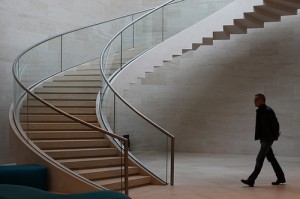
Do your staff members have a clear path for professional development? (Photo by Gwenael Piaser, and used under a Creative Commons license.)
As the blog posts at Design in Museum Studies--as well as countless career and business blogs--suggest, we are in an era where career paths are no longer a single, continuous narrative. Instead, professionals acquire their knowledge and expertise in a much more piecemeal fashion, and their careers may zigzag across industries and job functions. Take, as but one example, my own career (I was born in 1975): B.A. in English, creative writing M.A., development communications, K-8 educational publishing, community journalism, university teaching (literature and writing), arts marketing, science center outreach to schools, freelance writing, exhibition development, outdoor ed program development, program evaluation, more university teaching (American Studies), Ph.D. in cultural studies, instructional technology, teaching consultant, university teaching (museum studies), and professional development consulting. I held many of these jobs concurrently--and still do. I'm being furloughed for three weeks this year from my job at the UC Davis teaching center, and I can't know if the university will choose to keep my position (or even the teaching center) in the longer term, so my choices are born of not just intellectual curiosity and vocational restlessness, but also necessity. My generation, and those that follow mine, are neither satisfied with, nor realistically expect employers to provide, the kinds of stability that our parents may have enjoyed. Nor do we necessarily plan to grant our employers the depth of loyalty our parents and grandparents may have shown their employers.
Such confidence in ourselves (some have called it instead "a sense of entitlement," and in many cases I'm inclined to agree) doesn't mean, however, that we're necessarily savvy about our own professional development. In fact, we need institutional help in forecasting what shape the field will take, and which proficiencies and varieties of expertise we should cultivate.
Again, the institutional role is key, and many institutions--be they strapped for funds or able to afford to send multiple employees to each major conference--leave their staff's professional development in a much too ambiguous state. Recently I wrote at Museum Blogging about the seven best practices in professional development. The practices range from having specific learning and behavioral objectives to finding (or starting) engaging conversations at conferences, in the workplace, and online, and they emphasize creativity and connection.
You might find these practices all well and good, but still wonder how you can afford professional development for yourself or your staff. After all, the costs of association memberships, travel to conferences, and seminars can add up very quickly. If you don't have the resources for these kinds of investments, there is a less expensive, and decidedly 21st-century, way to advance professional development: social media. Consider this post a brief introduction, and feel free to contact me to talk about how you might apply social media to professional development at your institution.
Using social media in professional development
Conversations, networks, creativity, connection, virality: 21st-century professional development clearly calls for engagement with social media, as such platforms make it easier to achieve all these goals.
Social media is an excellent medium for professional development because
- It allows for both synchronous and asynchronous participation.
- Participants are active learners—that is, they are actively engaged in the construction of knowledge, not just passive receivers of it.
- Social media usually can be captured, thus providing not only an archive of the learning experience, but content that can be repurposed for future symposia, seminars, or courses.
- In learning to use social media within the context of professional development, staff learn new ways of engaging with audiences for their institutions.
- Engagement with social media involves multiple learning modalities and intelligences—visual, aural, textual, and more.
Briefly, here are some recent examples of individuals and institutions using social media to achieve learning objectives.
Dave Lester (@digitalhumanist) used Twitter to learn about mobile media and share what he learned:
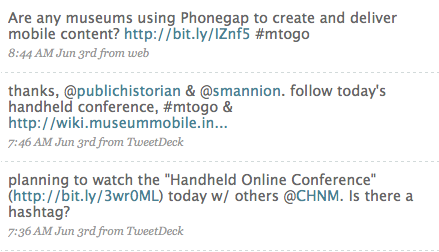
If you follow the right people on Twitter, you'll learn a ton and make some terrific, and mind-expanding, new connections. To find interesting Twitterfolk (or "Tweeps"), go to Twitter Search and enter a search term. Once you locate some interesting tweets, "follow" their authors and check to see whom these authors are following. Wash, rinse, repeat.
There are also some really strong museum blogs out there on which really enriching conversations are taking place. Off the top of my head, I'd say definitely check out the Center for the Future of Museums blog, Nina Simon's Museum 2.0, Kristen Olson's I am almost always on time, New Curator, bloggers@brooklynmuseum, and fresh + new(er) from the Powerhouse Museum. You can see a huge list of museum bloggers at Museum Blogs.
Museum folk in the know are making excellent use of forums in their own learning. The threads at Museum 3.0 are particularly thoughtful and thought-provoking. Here's a screenshot of recent threads in the Museum 3.0 forum:
As I write this blog post, active threads address such topics as funding and managing design festivals, a seminar by John Falk and Lynn Dierking in Canberra, social media and social history, and concerns about museum and gallery closures. While the site is ostensibly about imagining the future of museums, the more than 1,400 members of the site clearly are using it to address current issues and to advance their own learning as museum professionals. The site's sidebar displays RSS feeds from popular blogs by museum folks; at the moment are displayed links, for example, to a post by Seb Chan of the Powerhouse museum on the return on investment in social media, a post on what crowdsourcing design will mean for museums, and Nina Simon's musings on innovative punch-card systems that motivate deep engagement. Such blog posts might inspire threads within the Museum 3.0 forums, or conversation may continue within the comments sections of the individual posts.
It's easy to be overwhelmed by the hundreds of blogs written by museum professionals or the tens (if not hundreds) of thousands of pages about museums published in books, journals, reports, and white papers each year. Consider, then, part of the professional development process the ability to locate aggregators of information (like Museum 3.0) and to curate for oneself or others those resources that are worth revisiting.
Once you have figured out this particular variety of curation, learning through social media is powerful because it draws on networks that are both broad and deep. Social media allows us to discover and connect with new colleages and forge new friendships as we learn, as well as be inspired by our new contacts. See, for example, @injenuity's response to a question from Alex Couros (@courosa):

One advantage of working among museum people is that we really enjoy building things, and we're generally good at collaborating, both because we enjoy it and because we're used to scrounging a bit for resources. Such inclinations make wikis an excellent platform for collaborating--they're frequently free and easy to use, and often the more contributors, the stronger the end product. Such wikis can benefit a single institution or multiple institutions. The Smithsonian, for example, has created a wiki called Re-Imagining the Smithsonian in the Digital Age. Its goal is to collect the thoughts and ideas of those who attended, or who watched the webcasts of, a Smithsonian 2.0 event in January 2009. It is open, therefore, to the public. Such openness is one hallmark of the social media age—witness the Flickr Commons, for example, where museums make available photos on which there are no known copyright restrictions, and where visitors can tag, label, and share their knowledge about the photographs' subjects—and can only benefit the quality of professional development in the museum field as a whole.
Planning for social media--and capturing content
Institutions, or consortia of institutions, looking to set up a more formal professional development program for staff should definitely consider using digital media, and particularly social media, in their plans. Social media not only promotes interactive learning and collaboration, but also can be captured for future viewing or reading by people who could not participate in an event or conversation. Such recordings and other captured content might become an additional source of revenue for museums as they can be repackaged into short courses for consumption by those outside the museum or consortium. These courses might be entirely virtual and self-paced, or hybrid courses where participants check in with an instructor weekly. (I'm happy to help set up such a course or any other individual or communal professional development plan; please contact me at Leslie@EagerMondays.com.)
To better illustrate this process, here’s a sketch of a sample professional development workflow incorporating social media:
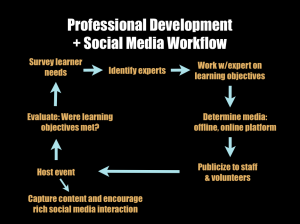
This workflow diagram reminds us to be both deliberate in our planning for learning and in our capture of professional development events and programs so that they can be enjoyed by future staff members or employees of far-flung museums. Institutions that "get" the digital aspects of this workflow are in a particularly advantageous place, as they can provide, for a fee or merely for gratitude, other institutions' staff access to programs initiated at the museum. (Of course, an individual could also develop a much more modest social media workflow for herself; this one thinks big.)
Benefits to institutions
Those who learn to use social media well in their own professional development can then use it to the advantage of their institutions. Witness this tweet from the National Museum of Natural History (@NMNH):

. . .or this blog post that merges social media, museum collections, and pop culture at the Brooklyn Museum's blog:
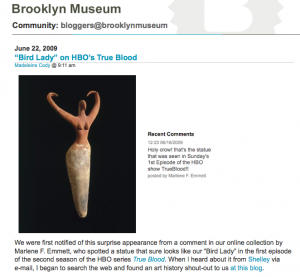
Social media allows for rich intertextuality, which means more interdisciplinary learning and likely more web search traffic as well.
Professional development can be messy
When I was an undergraduate at Grinnell College, the college was an expanse of brick buildings and manicured lawns. When I returned
for a visit in the fall of 2007, I saw that the college had seeded the area along the railroad tracks that cut through campus with prairie grasses. At first, I found the autumn prairie grasses to be tangled, weedy, and unattractive. But upon closer inspection, I discovered a wonderful diversity of plants thriving in close quarters, providing one another, perhaps, with mutual support and protection from pests.

Prairie photo by Tim Lindenbaum, and used under a Creative Commons license
"Training" workshops that seek only to convey content, to promote a uniform philosophy among staff without recognizing the existing expertise and creativity of individuals by encouraging them to contribute, are more like carefully tended suburban lawns, monotone and polluting. For successful and
high-impact professional development, be willing to tear up those metaphorical institutional lawns and replace them with native grasses or a vegetable garden. Professional development can at first seem messy, but there are tremendous benefits in showcasing a diversity of experience and perspective across a variety of platforms.
What are your thoughts? How is social media helping your professional development or that of your staff?
If you like this post, you can get more resources coming your way by signing up for this free, low-volume e-mail newsletter.
Leslie Madsen-Brooks is the founder of Eager Mondays, a consulting practice that cultivates unconventional professional development across a broad spectrum of organizations--but museums are her favorite. She is also an adjunct professor of museum studies at John F. Kennedy University and a teaching consultant at the University of California, Davis. You can find her at EagerMondays.com or MuseumBlogging.com, and contact her at Leslie@EagerMondays.com.

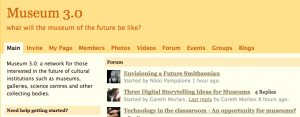







Comments
hey, Leslie, et. al., you saw this?
http://museumblogthesis.blogspot.com/2009/08/talkin-museum-studies-blues...
Here's another fantastic example of the power of Twitter: http://bit.ly/63snW
Thanks so much for all of your comments; I really appreciate your feedback.
NewCurator, you're absolutely right that professional development through social media is difficult to measure. One of the joys of social media, for me at least, is the serendipitous discoveries it engenders. That said, in order to measure/evaluate professional development, individuals and institutions need to be a bit more deliberate--and much more explicit--about learning objectives and outcomes. I wrote a little bit about this in a post at Museum Blogging, giving an example of some objectives and outcomes.
If anyone has other ideas on how to measure or evaluate professional development in ways that go beyond the traditional (and, alas, many times ineffective), I'd love to hear them!
Hello Leslie and thank you for your thoughtful posting. It really highlights how multi-disciplinary the museum environment really is. Professional development seems to always be such a bone of contention,particularly as conferences are expensive and chosing the right training program is sometimes elusive. I've been thinking about what types of resources would be valuable as an online tool kit.
Thanks for the museum3.0 mention. It is a tremendous network and one which, coupled with twitter, has possibly done more to connect me with the best thinkers, writers and creators in the sector than any paper I've written ever has!
You might be interested in this recent discussion on the collaboration between Wikimedia and the GLAM (galleries, libraries, archives, museums) sector at http://nlablog.wordpress.com
Thanks again
This also reminds me of the thread on Museum 3.0, "Do we need to have conferences anymore?" (http://museum30.ning.com/forum/topics/do-we-need-to-have-conferences), where we talked about how social media may be used as an adjunct to the F2F aspects of a conference.
I enjoyed reading your post and agree that social media is an important component of professional development. Using Twitter I have found great articles and blogs about fund raising, museum issues, and benefitted from reading about the success and failures of museums. Whether following individuals or institutions, there is always something beneficial. I do continue to believe in the importance of traditional meetings/conferences. As this past weekend's Leadership Conference presented by the Texas Association of Museums demonstrated, face-to-face communication and learning will always be a very important component of our professional development.
Thank you Leslie for this thoughtful post. I agree with you that as budgets shrink museums (and indeed all organisations) need to be thinking not about how to cut the training/professional development budgets, but how to continue what is a vital part of our jobs with using social media as a viable option.
Your comments about Twitter are particularly useful as I still find many people cannot see any value in it, and the example you cite is a really good one.
Thank you for mentioning Museum 3.0. It is certainly an initiative that I never realised would take off in the way it has. It's still a bit clunky and we're still leanring about how best to engage members, but 1,400 people seem to have found a use for it and that's to be celebrated!
I was also struck by your observations on employment - there are many people who have worked in our sector almost their whole lives and I think will be really challenged (and also threatened) by the different attitudes to employment across other generations. To me it comes down to having what I call a 'web 2.0 mindset' - flexible outlook, recognising we live in a perpetual beta world and be willing to take a risk and learn from that - that is as much a part of our working lives as a permanent job for life as this will soon no longer be the case.
Thanks again and best of luck.
this is awesome! a real one-stop shop for revving up in a plugged-in world.
if I'd've stumbled across this three years ago, I could have saved myself a lot of discovery time.
so this means those who start here have a leg up and together we are all just going to get to the next place even faster, right?
here's to exponential increases in learning!
great post, @lesliemb!
I agree completely - this is a truly EXCELLENT post. Thank you very much for posting this!
Well, I've been put into quite a shortlist, thank you. I wonder if I should behave myself more...
I think there's something missing to this. Not the idea or the outcome but a mechanism for the transition. I really like the idea of social media as professional development tool (Hell, it's done wonders for me) but the difference to old methods may be too great.
What I'm talking about is that the usual ways of professional development are pretty linear, which means there are ways to measure them.
One of the positives inherent in the design of social media is how they... "snowflake"... outwards and in odd directions. This is the mechanism that I think is missing to make social media professional development even better/more useful etc. is a way to measure it (at least, beyond that of "done" or numbers)
Thanks so much for posting this. I am looking at the careers of my younger colleagues as well as my own family members in the humanities sector. Something struck me in your discussion: I do see a great divide between the newer generation who do not have resources provided by their institution, institutions that cannot or will not invest in staff who may be leaving soon, and staff that cannot depend on having a long term career with that institution. So, learning in the leveling pool of sumptuous social media with the "experienced" older colleagues and the "cutting edge" newer colleagues is a forum that is liberating and revolutionary. None of us knows exactly how the future of museums will reinvent itself; I have an inkling that we are experiencing it as we blog. Thanks so much for your words, resources and generous offerings. It bodes well for the new wave of learning we are all riding. These museums of the mind show us that the internet is not all that ephemeral... real people with real ideas preserve that which is real for our time. I am reminded of a time not that long ago when all knowledge was preserved within the recitations of individual to individual; those of us who are anthropologists call this format "oral tradition." Now, we have knowledge streaming to each other in a new but similar manner, a "social media tradition." I think it tells us so much about the human mind and our technology legacy. Fascinating. Thanks so much for reminding us of this wild-seeded landscape as we emerge from the cultivated fields of the 20th century.
Leslie,
This is a terrific post. Thank you so much for synthesizing so much great information for us all in one place. My response is too long for a comment, but visit my blog to see how I am addressing this whole issue: http://bit.ly/qmQ5b
Add new comment